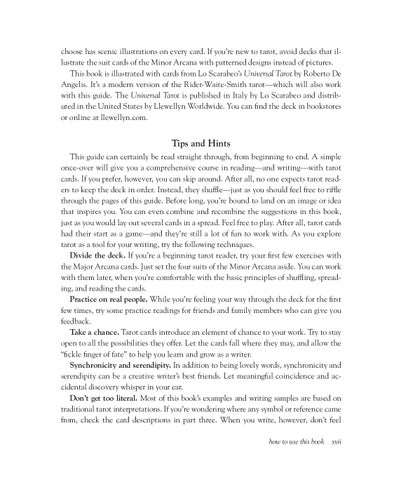choose has scenic illustrations on every card. If you’re new to tarot, avoid decks that illustrate the suit cards of the Minor Arcana with patterned designs instead of pictures. This book is illustrated with cards from Lo Scarabeo’s Universal Tarot by Roberto De Angelis. It’s a modern version of the Rider-Waite-Smith tarot—which will also work with this guide. The Universal Tarot is published in Italy by Lo Scarabeo and distributed in the United States by Llewellyn Worldwide. You can find the deck in bookstores or online at llewellyn.com.
Tips and Hints This guide can certainly be read straight through, from beginning to end. A simple once-over will give you a comprehensive course in reading—and writing—with tarot cards. If you prefer, however, you can skip around. After all, no one expects tarot readers to keep the deck in order. Instead, they shuffle—just as you should feel free to riffle through the pages of this guide. Before long, you’re bound to land on an image or idea that inspires you. You can even combine and recombine the suggestions in this book, just as you would lay out several cards in a spread. Feel free to play. After all, tarot cards had their start as a game—and they’re still a lot of fun to work with. As you explore tarot as a tool for your writing, try the following techniques. Divide the deck. If you’re a beginning tarot reader, try your first few exercises with the Major Arcana cards. Just set the four suits of the Minor Arcana aside. You can work with them later, when you’re comfortable with the basic principles of shuffling, spreading, and reading the cards. Practice on real people. While you’re feeling your way through the deck for the first few times, try some practice readings for friends and family members who can give you feedback. Take a chance. Tarot cards introduce an element of chance to your work. Try to stay open to all the possibilities they offer. Let the cards fall where they may, and allow the “fickle finger of fate” to help you learn and grow as a writer. Synchronicity and serendipity. In addition to being lovely words, synchronicity and serendipity can be a creative writer’s best friends. Let meaningful coincidence and accidental discovery whisper in your ear. Don’t get too literal. Most of this book’s examples and writing samples are based on traditional tarot interpretations. If you’re wondering where any symbol or reference came from, check the card descriptions in part three. When you write, however, don’t feel how to use this book xvii
